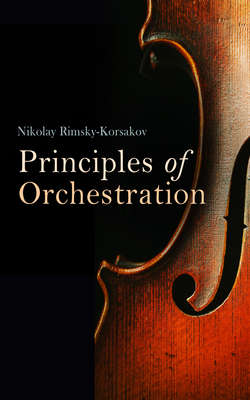Читать книгу Principles of Orchestration, with Musical Examples Drawn from His Own Works - Rimsky-Korsakov Nikolay - Страница 8
На сайте Литреса книга снята с продажи.
Table A. String group.
Оглавление(These instruments give all chromatic intervals.)
Black lines on each string denote the general range in orchestral writing, the dotted lines give the registers, low, medium, high, very high.
The five sets of strings with number of players given above produce a fairly even balance of tone. If there is any surplus of strength it must be on the side of the first violins, as they must be heard distinctly on account of the important part they play in the harmonic scheme. Besides this, an extra desk of first violins is usual in all orchestras, and as a general rule they possess a more powerful tone than second violins. The latter, with the violas, play a secondary part, and do not stand out so prominently. The 'cellos and double basses are heard more distinctly, and in the majority of cases form the bass in octaves.
In conclusion it may be said that the group of strings, as a melodic element, is able to perform all manner of passages, rapid and interrupted phrases of every description, diatonic or chromatic in character. Capable of sustaining notes without difficulty, of playing chords of three and four notes; adapted to the infinite variety of shades of expression, and easily divisible into numerous sundry parts, the string group in an orchestra may be considered as an harmonic element particularly rich in resource.
